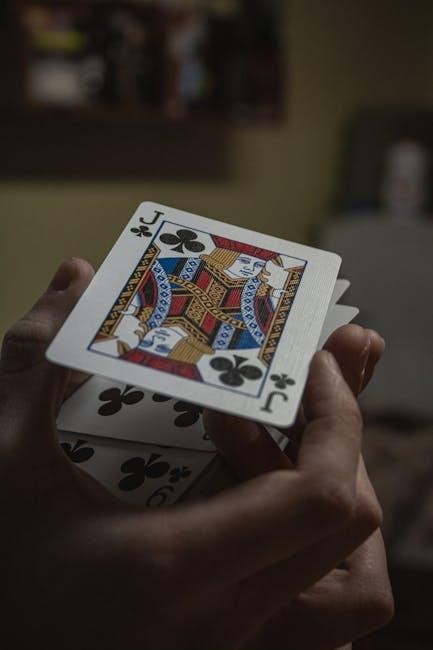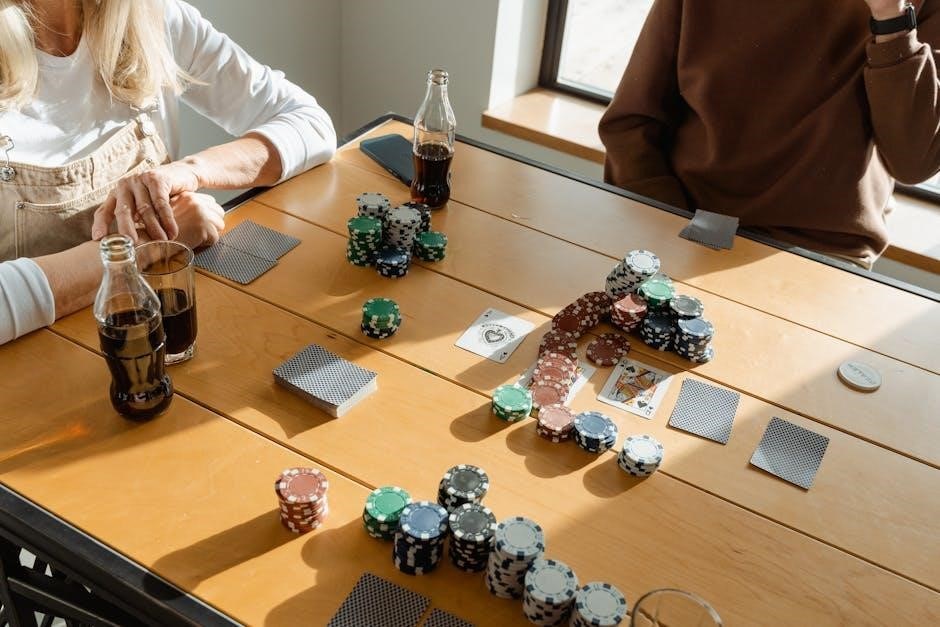Hand and Foot is a popular card game variation of Canasta, played with 2-6 players using multiple decks․ It involves strategy, melding cards, and discarding to win points․
Overview of the Game
Hand and Foot is a dynamic and strategic card game closely related to Canasta, offering a fun and engaging experience for 2 to 6 players․ Played with multiple decks (typically 5-6 decks including jokers), the game involves forming sets of cards called “melds” to score points․ Players aim to discard all their cards by first emptying their “Hand” and then their “Foot․” The game is known for its unique structure, where each player manages two separate sets of cards, adding an extra layer of strategy․ Jokers and wild cards add excitement, while team play enhances collaboration․ With clear rules and a balance of luck and skill, Hand and Foot appeals to both casual and competitive players, making it a beloved choice for card game enthusiasts of all ages and skill levels;
History and Origins
Hand and Foot is a North American variation of the popular card game Canasta, which originated in Uruguay in the 1940s․ Canasta gained worldwide popularity in the mid-20th century, leading to the creation of various adaptations, including Hand and Foot․ This version emerged as a simpler and more accessible alternative to traditional Canasta, making it easier for new players to learn and enjoy․ Hand and Foot became particularly popular in social circles and community groups, where its team-based gameplay and strategic depth resonated with card game enthusiasts․ Over time, the game has evolved with house rules and variations, but its core roots in Canasta remain evident․ Its enduring appeal lies in its balance of simplicity and strategy, making it a beloved choice for gatherings and casual play․

Setup and Preparation
Hand and Foot requires 5-6 decks of cards, including jokers, depending on the number of players․ Each player receives two sets of 11 cards: the hand and the foot․
Number of Players and Teams
Hand and Foot is a versatile card game that can be played with 2 to 6 players, making it ideal for small or larger groups․ The game is typically played in teams, with 4 players forming two teams of two․ However, it can also be adapted for 3 or 5 players by adjusting the team sizes accordingly․ For 6 players, the game is usually divided into three teams of two․ The number of decks used increases with more players, ensuring there are enough cards for everyone․ While the game can be played with 2 players individually, the team dynamic adds an extra layer of strategy and collaboration․ The flexibility in team sizes makes Hand and Foot a great option for various social gatherings or casual game nights․
- 2-6 players can participate․
- Typically played in teams of two or three․
- More decks are added for larger groups․
- Team play enhances strategy and communication․
The game’s adaptability to different group sizes makes it a popular choice for both intimate and lively settings․
Card Decks and Jokers
Hand and Foot is played using multiple decks of standard playing cards, including Jokers․ The number of decks used depends on the number of players, with each player requiring their own deck․ For example, a game with 4 players uses 4 decks, while 6 players require 6 decks․ Jokers are included in the game and act as wild cards, adding an extra layer of strategy․ The decks are shuffled together to create a large stockpile of cards, ensuring a dynamic and unpredictable gameplay experience․ The inclusion of Jokers and multiple decks makes the game more exciting and challenging, as players must adapt to the variety of cards in play․ This setup ensures that the game remains engaging and fast-paced, regardless of the number of participants․
- Multiple decks are used, one per player․
- Jokers are included as wild cards․
- Decks are shuffled together into a single stockpile․
- Wild cards add strategic depth to the game․
The combination of multiple decks and wild cards enhances the game’s complexity and fun factor․
Dealing the Cards
Dealing is a crucial step in Hand and Foot, ensuring each player starts with the appropriate number of cards․ Each player receives two separate sets of cards: a “hand” and a “foot․” The hand consists of 11 cards, while the foot also contains 11 cards․ The foot remains face down until the hand is fully played․ The dealer distributes the cards one at a time to each player, alternating between the hand and foot piles․ Once all cards are dealt, the remaining cards form a stockpile․ The top card of the stockpile is turned over to start the discard pile․ Players can then examine their hand but must keep the foot face down until they are ready to play it․ This structured dealing process ensures fairness and prepares players for the strategic gameplay ahead․
- Each player receives a hand and a foot, each with 11 cards․
- The foot remains face down until the hand is played․
- Dealing alternates between hand and foot piles․
- Remaining cards form the stockpile․
- The top card starts the discard pile․
Proper dealing is essential for a smooth and balanced game․
Structure of Hand and Foot
Hand and Foot is structured around two sets of cards: the “hand” and the “foot․” Each player receives 11 cards for their hand and 11 cards for their foot․ The hand is played first, and once all cards in the hand are discarded, the foot is played․ The game uses multiple decks, typically five to six standard decks of 52 cards each, including Jokers as wild cards․ The combination of these decks creates a large stockpile, ensuring a dynamic and lengthy gameplay experience․ The structure of the game requires players to manage both sets of cards strategically, as the foot cannot be played until the hand is fully discarded․ This unique dual-card system adds complexity and depth to the game, making it a favorite among card game enthusiasts․
- Each player has 11 cards in their hand and 11 in their foot․
- The hand is played first, followed by the foot․
- Uses 5-6 decks, including Jokers as wild cards․
- The foot cannot be played until the hand is fully discarded․
This dual-card structure enhances the game’s strategic appeal․

Objective of the Game
The objective is to be the first to discard all cards from your hand and foot while scoring the most points․ Teams aim to reach the highest point total to win․
Getting Rid of Cards
Getting rid of cards is central to the game․ Players must discard all cards from their hand first, then their foot, by melding or discarding․ Melding involves creating sets of 3-7 cards of the same rank or runs of sequential cards․ Discarding is the final step, allowing players to eliminate their cards strategically․ Once the hand is cleared, players can access the foot, which remains face down until then․ Teams or players must efficiently manage their cards to eliminate them before opponents․ Properly timing when to discard or meld is crucial for success․ The goal is to be the first to eliminate all cards, showcasing strategic planning and card management skills․ This step-by-step process ensures the game progresses toward a decisive conclusion, where the fastest to clear their cards emerges victorious․
Scoring Points
Scoring points in Hand and Foot is based on the value of cards melded and penalties for unmelded cards․ Each card has a specific point value: Aces, Kings, and Queens are worth 10 points, Jacks are 5 points, and Jokers and wild cards are 20 points․ Number cards are worth their face value, while 3s are unique, often acting as wild cards but sometimes having special rules․ Points are accumulated by melding valid sets or runs, with bonuses for going out first or achieving specific combinations․ Penalties are applied for any cards left in a player’s hand or foot at the end of the game․ Teams or players aim to maximize their score by strategically melding high-value cards and minimizing penalties․ The goal is to reach the highest total points, making every card count in the pursuit of victory․
Winning the Game
Winning Hand and Foot requires being the first to discard all cards from both your hand and foot․ The game concludes when a player successfully melds all their cards, with their team reaching the highest score․ Points are tallied based on the value of melded cards, with bonuses for going out first․ Penalties are deducted for any unmelded cards left in a player’s hand or foot․ The goal is to accumulate the most points by strategically melding cards and minimizing penalties․ The first team or player to reach a predetermined score, often 20,000 points, is declared the winner․ Winning also involves efficiently using wild cards and achieving specific combinations to maximize points․ The game demands skill, strategy, and quick thinking to emerge victorious․

Gameplay Rules
Hand and Foot involves melding cards, discarding, and strategically using wild cards․ Players must play all hand cards before accessing the foot․ The goal is to minimize penalties and maximize points by forming valid combinations efficiently․
Melding Cards
Melding is a core aspect of Hand and Foot, where players combine cards into sets of 3-7 cards of the same rank․ These sets, known as “melds,” can be laid down on the table to score points․ A valid meld must consist of at least three cards, and players can use wild cards (like Jokers) to substitute for missing cards․ However, a meld cannot consist solely of wild cards—it must include at least two natural cards․ Once a meld is laid down, other players can add to it by matching the rank of the cards in the meld․ Melding strategically is key, as it helps players discard cards quickly and earn points․ The ability to extend melds adds a layer of teamwork and strategy, especially in team-based variations of the game․

Going Out
Going out is a crucial objective in Hand and Foot, where a player discards all cards in their Hand and then their Foot․ To go out, a player must discard the last card in their Hand during their turn, either by melding or discarding it․ Once the Hand is cleared, the player can then work on discarding the Foot․ A player cannot start playing the Foot until the Hand is completely emptied․ If a player needs to discard to clear their Hand, they must wait until their next turn to begin using the Foot․ Successfully going out earns a bonus and can significantly impact the game’s outcome․ Timing and strategy are essential, as going out first can give a player or team a competitive edge․ Proper planning ensures smooth progression from Hand to Foot, maximizing scoring opportunities․

Using Jokers and Wild Cards
In Hand and Foot, Jokers and wild cards play a significant role in gameplay․ Jokers are included in the decks and act as wild cards, capable of representing any card rank or suit․ Players can use wild cards to complete or enhance melds, making them highly valuable․ However, there are restrictions: wild cards cannot form a meld on their own and must be paired with at least two natural cards of the same rank․ Additionally, wild cards cannot be used to represent other wild cards․ Using Jokers strategically can greatly benefit a player, allowing them to complete difficult melds or extend existing ones․ However, over-reliance on wild cards can backfire, as they do not contribute to scoring unless part of a valid meld․ Properly utilizing wild cards is a key skill in mastering the game, balancing their versatility with their limitations․

Discarding Cards
Discarding cards is a crucial part of the Hand and Foot game, allowing players to reduce their hand and progress toward winning․ A player may discard one card per turn, placing it face-up on top of the discard pile․ Discarding is typically done after drawing a card and before the end of the turn․ However, players cannot discard a card if they have already melded or laid off cards during that turn, unless it is their last card․ If a wild card (such as a Joker) is discarded, it cannot be picked up by another player unless they have two natural cards of the same rank to form a valid meld․ Proper discarding strategy is essential, as it can either hinder or help opponents․ Players must balance discarding unwanted cards with the risk of aiding others in completing their melds․

Card Values and Scoring
Card values vary, with Aces and 2s worth 20 points, face cards worth 10, and 3s as 5 points․ Jokers are wild and score 20․ Points are tallied based on melded cards․
Point Values for Each Card
In Hand and Foot, each card has a specific point value that contributes to the overall score․ Aces and 2s are worth 20 points each, while Kings, Queens, and Jacks are valued at 10 points each․ Number cards from 3 to 10 are worth 5 points each․ Jokers, acting as wild cards, also carry a value of 20 points․ These point values are crucial as they determine the score for melded cards and the overall game․ Understanding the card values helps players strategize effectively, as higher-value cards significantly impact the total points․ Accurate tracking of these values ensures fair scoring and competitive gameplay․ The point system is a key aspect of the game, making it essential to familiarize oneself with each card’s worth to maximize scoring opportunities․
Scoring Combinations
Scoring in Hand and Foot is based on the combinations of cards players meld during the game․ A valid meld consists of at least three cards of the same rank (a set) or three or more consecutive cards of the same suit (a sequence)․ Each melded combination contributes to the player’s or team’s score, with points calculated based on the value of the cards involved․ For example, a set of three Kings would score 30 points, while a sequence of 5, 6, and 7 of hearts would score 15 points․ Wild cards, such as Jokers, can replace missing cards in a meld, but they carry a higher point value themselves․ The strategy of forming high-value combinations while minimizing penalties is key to winning․ Points from all melded cards are summed to determine the final score, making combinations the core of the game’s scoring system․
Penalties and Bonuses
Penalties and bonuses play a crucial role in the scoring system of Hand and Foot․ Players incur penalties for holding certain cards in their hand or foot when another player goes out․ Aces and 2s are typically penalized, as well as Jokers, which carry higher point values․ Additionally, any unmelded cards in a player’s hand or foot at the end of the game result in penalties, deducting from their total score․ On the other hand, bonuses are awarded for specific achievements, such as going out, which grants a significant 100-point bonus․ Players can also earn bonus points by laying off cards onto existing melds, adding to their score․ Wild cards, such as Jokers, can be used to complete melds but carry higher penalties if left unmelded․ Balancing penalties and bonuses is essential for maximizing points and securing a win․
Tracking Points
Tracking points in Hand and Foot is essential to determine the winner․ Points are accumulated by creating valid melds, while penalties are deducted for unmelded cards․ Each game round ends when a player goes out, and all players’ remaining cards are scored․ Teams or players must keep a running total of their points across rounds․ The goal is to reach a predetermined target score, often 20,000 points, to win the game․ Proper tracking ensures fair play and accurate scoring․ Players must carefully record points after each round, adding bonuses for going out and subtracting penalties for unmelded cards․ This system ensures transparency and keeps the game organized, allowing players to strategize effectively for the next rounds․

Strategies and Tips
Mastering Hand and Foot requires strategic planning and smart card management․ Focus on creating strong melds, using wild cards wisely, and communicating effectively in team play to maximize points and outmaneuver opponents․
General Strategies
Success in Hand and Foot requires a mix of planning, coordination, and adaptability․ Players should focus on creating strong melds early to reduce their card count and maximize scoring opportunities․ Teamwork is crucial, especially in team-based play, as communicating strategies and coordinating melds can significantly enhance your chances of winning․ Always prioritize high-value cards and wild cards, as they can greatly impact your score․ Managing your hand and foot effectively involves balancing the need to discard cards quickly while avoiding unnecessary penalties․ Pay attention to the cards your opponents discard, as this can help you anticipate their strategies and disrupt their plans․ Additionally, timing is key—know when to hold onto cards for potential future melds and when to discard them to prevent losing points․ By combining these strategies, you can outmaneuver your opponents and achieve victory․
Managing Your Hand
Effectively managing your hand is essential to success in Hand and Foot․ Start by organizing your cards into potential melds, focusing on sets of three to seven cards of the same rank․ Prioritize high-value cards and wild cards, as they can significantly impact your score․ Keep track of the cards that have been discarded to better anticipate your opponents’ moves․ When melding, aim to create strong, versatile sets that can be expanded later․ Avoid holding onto low-value cards that are unlikely to form melds, as they may become penalties․ Coordinate with your teammate to ensure you’re both working toward complementary goals․ Timing is also critical—know when to discard cards to clear your hand or when to hold onto them for future melds․ By staying organized and strategic, you can efficiently manage your hand and set yourself up for victory․
Using Wild Cards Effectively
Wild cards, such as jokers and deuces, are powerful tools in Hand and Foot, offering flexibility in forming melds․ Use them strategically to complete sets or sequences when natural cards are unavailable․ However, avoid wasting wild cards on low-value melds, as they are most valuable in high-scoring combinations․ For example, using a joker to complete a set of aces can significantly boost your score․ Wild cards can also be used to extend existing melds, allowing for more points․ Be cautious, however, as opponents may take advantage of your reliance on wild cards․ Always consider the cards that have been discarded to anticipate your opponents’ potential moves․ Timing is key—use wild cards to finish your hand or foot when needed, but avoid overusing them early in the game․ Effective use of wild cards can turn a challenging situation into a winning one, making them a crucial part of your strategy․
Team Play Strategies
In Hand and Foot, teamwork is essential for success․ Players must communicate and coordinate their moves to maximize points and outpace opponents․ A key strategy is to focus on melding cards that complement your partner’s potential plays, ensuring a balanced approach․ Protecting the discard pile by avoiding unnecessary discards is crucial, as it prevents opponents from completing their melds․ Additionally, plan the use of wild cards strategically to benefit both you and your teammate․ Coordinate your efforts to finish your hand and foot simultaneously, allowing your team to score points before opponents․ Monitor the cards your partner has played to anticipate their needs and avoid conflicts․ By working together and maintaining clear communication, your team can effectively outmaneuver opponents and secure victory․ Effective teamwork often makes the difference between winning and losing in this dynamic card game․

Game Variations
Hand and Foot offers various formats, including different deck numbers, house rules, and player counts․ Common variations include 2-6 players, with options for team or solo play, enhancing game diversity․
Common Variations
Hand and Foot is adaptable, with variations to suit different preferences․ Common versions include 2-6 players, often in teams, using 5-6 decks with jokers․ Some play with fewer decks for simplicity, while others add house rules like special 3s or wild card restrictions․ The game can also be played solo or in three-player formats, though team play is most traditional․ Variations may adjust melding rules, such as requiring more cards to form a valid set or allowing specific combinations․ These tweaks keep the game fresh while maintaining its core objective of melding and discarding cards strategically․ House rules often personalize the game, making it unique to each group․ Despite variations, the essence of Hand and Foot remains consistent, focusing on strategy and efficient card play․
House Rules
House rules in Hand and Foot allow players to customize the game to their preferences․ Common adjustments include modifying the number of decks, altering point values, or changing discard rules․ Some groups introduce “special 3s” or restrict wild card usage․ For example, jokers and deuces may be limited to forming melds with natural cards․ Others modify penalties for holding cards after going out or adjust the minimum number of cards required for initial melds․ Teams might also agree on unique scoring systems or bonus points for specific combinations․ House rules often simplify or enhance complexity, making the game more enjoyable for the group․ These variations ensure that Hand and Foot remains adaptable and engaging, catering to diverse playing styles and preferences․ Personalizing the rules allows players to create a version that suits their experience level and competitive spirit․
Different Formats
Hand and Foot can be played in various formats to suit different preferences․ The most common format involves 4 players divided into two teams, but it can also be played with 2-6 players․ For larger groups, additional decks are added to accommodate more players․ Some variations allow for individual play rather than teams, while others introduce alternate scoring systems․ The game can also be simplified for beginners by reducing the number of decks or relaxing melding rules․ Additionally, some players opt for shorter games by setting a lower total point target, such as 10,000 points instead of 20,000․ These variations make Hand and Foot adaptable to different group sizes and skill levels, ensuring the game remains enjoyable for everyone involved․ The flexibility of formats is a key reason for its enduring popularity as a social card game․
Hand and Foot is a dynamic and engaging card game that combines strategy, skill, and social interaction․ Its versatility allows it to be enjoyed by players of all skill levels, from casual gatherings to competitive matches․ The game’s structure, involving both a hand and a foot, adds a unique layer of complexity that sets it apart from other card games․ With its rich history and adaptable rules, Hand and Foot remains a beloved choice for many․ Whether played individually or in teams, the goal of melding cards and scoring points ensures endless entertainment․ By mastering the rules and strategies outlined, players can fully embrace the excitement of this timeless game and enjoy countless hours of fun with friends and family․